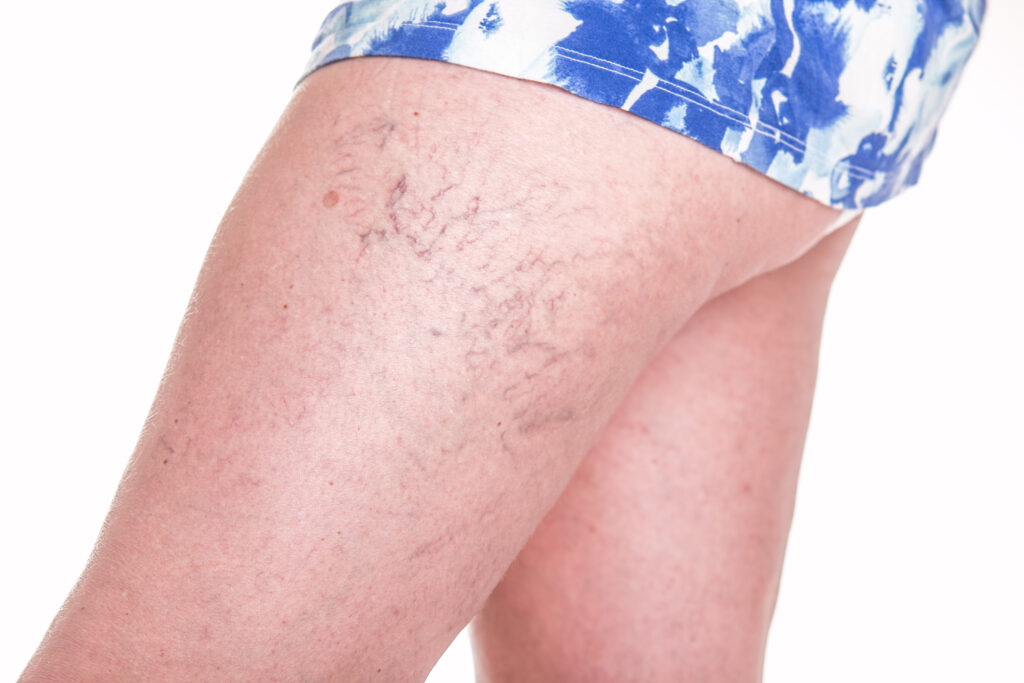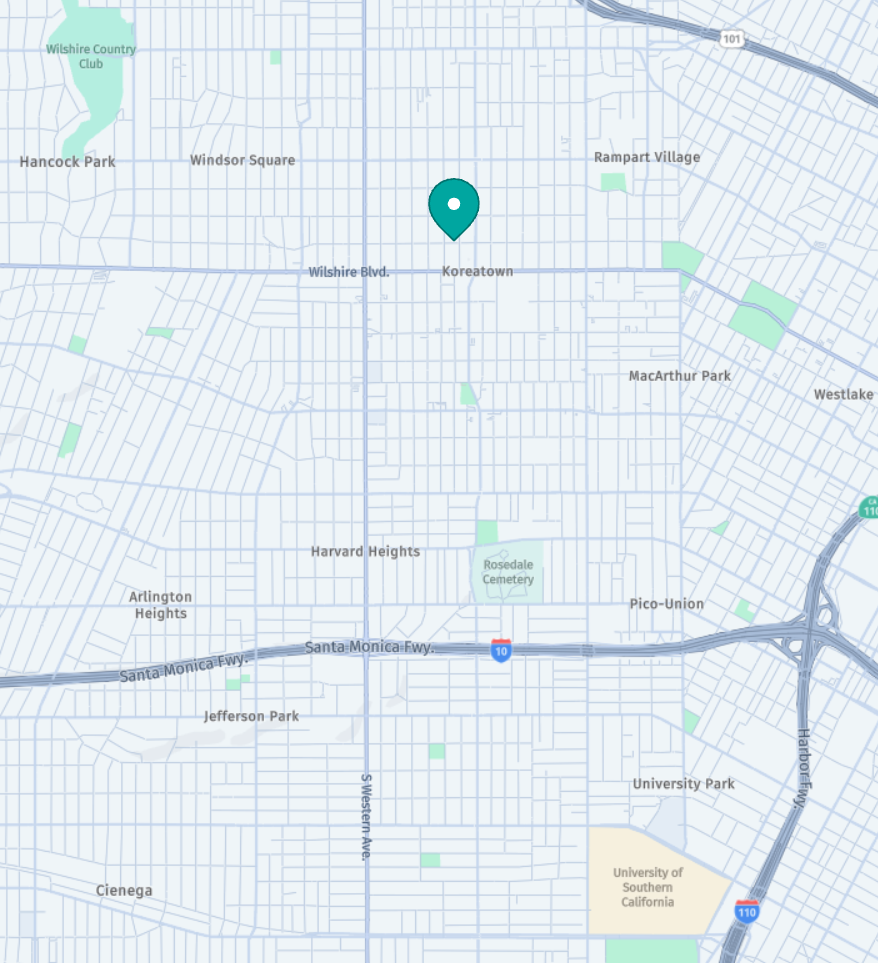Vein Treatments in Los Angeles, CA
Vein disease can cause aching, swelling, heaviness, skin discoloration, and visible veins that interfere with comfort and daily activities. Many people don’t realize that problems like varicose veins develop from underlying venous reflux rather than surface-level issues alone. Research suggests that around 40% of adults experience some form of venous disorder, highlighting how common these conditions are and why accurate diagnosis matters.¹ Even if your visible veins aren’t causing noticeable symptoms, you might be interested in eliminating them for cosmetic reasons. Fortunately, all of these issues can be improved with the right vein treatments.
At our Koreatown practice, Dr. Christopher Kim offers vein care grounded in a strong surgical background and years of focused experience treating chronic venous disease. His training allows him to recognize patterns that are often overlooked in cosmetic settings and to distinguish surface-level concerns from deeper circulation issues. Patients receive careful evaluation, thoughtful guidance, and treatment plans shaped by a deep understanding of how vein disorders develop and progress over time.
Ambulatory Phlebectomy
Ambulatory phlebectomy uses tiny openings to remove bulging surface varicose veins. Stitches are not required. This option is often recommended when surface veins remain after treating deeper reflux or when veins cause irritation, swelling, or discomfort. Patients typically walk immediately afterward and return to normal routines quickly.
ClariVein
ClariVein is a non-thermal treatment that closes faulty veins using a rotating catheter paired with a medicated solution. Because it does not use heat, it does not require tumescent anesthesia. It may be appropriate for patients who prefer an alternative to laser or radiofrequency techniques.
Compression Treatment
Compression is widely used to support circulation and ease symptoms such as swelling, leg fatigue, or heaviness. It may be used alone or paired with a procedure. Compression stockings also play a role in recovery after certain treatments.
Cosmetic Vein Treatments
Cosmetic vein care focuses on small surface veins that do not involve venous reflux. These include spider veins and small reticular veins. Treatments may involve visual sclerotherapy or other non-invasive methods, depending on vein size and progression.
Endovenous Laser Therapy (EVLT)
EVLT uses laser energy delivered through a thin fiber to close refluxing veins from within. This redirects blood toward healthier veins. EVLT is commonly used for saphenous vein reflux and is supported by clinical research showing strong closure rates and symptom improvement.
Endovenous Radiofrequency Ablation (RFA)
RFA uses radiofrequency energy to gently warm and seal malfunctioning veins. It is widely used for symptoms such as heaviness, swelling, leg fatigue, and skin changes related to chronic venous hypertension. Recovery is typically short, and patients often resume normal activity the same day.
Visual Sclerotherapy
Visual sclerotherapy treats surface-level spider veins and small reticular veins that are visible through the skin. These veins do not require ultrasound because they are close to the surface and usually cosmetic rather than medical in nature. A fine needle injects a solution into the vein, causing it to close and fade over time.
Visual sclerotherapy is suited for:
- Spider veins
- Small blue or green surface veins
- Surface clusters without deeper reflux
This treatment is different from ultrasound-guided sclerotherapy, which targets deeper malfunctioning veins that contribute to symptoms such as swelling, heaviness, or recurring clusters of surface veins.
Ultrasound-Guided Sclerotherapy
Ultrasound guidance allows medication to be delivered into deeper diseased veins that cannot be seen on the surface. This option is recommended when venous insufficiency is confirmed and can improve circulation patterns and leg comfort. It is not intended for cosmetic concerns alone.
Varithena
Varithena is a foam formulation used to close veins that are difficult to treat with catheters or heat. It reaches tortuous or winding veins and may be used for recurrent varicose veins or veins not well suited for thermal ablation.
VenaSeal
VenaSeal uses a medical adhesive to close a malfunctioning vein without heat or tumescent anesthesia. The adhesive seals the vein quickly, and many patients do not need compression afterward. This option may benefit those who prefer a non-thermal approach.
Venous Ultrasound
Venous ultrasound is the foundation of medical vein diagnosis. It evaluates blood flow, valve function, and the presence of venous reflux. This information guides personalized treatment recommendations and helps prevent unnecessary or incomplete care.
Why Choose Vein & Wound Center of LA for Vein Care in Los Angeles?
Dr. Christopher Kim brings extensive experience in chronic venous disease and minimally invasive procedures. He performs detailed evaluations before recommending treatment, helping patients receive care aligned with their symptoms and goals.
People choose our practice for:
- Ultrasound-driven diagnostic accuracy
- Minimally invasive procedures performed in a clinical setting
- A Koreatown location with secure, free garage parking
- A focus on long-term outcomes rather than short-term cosmetic fixes
- Care that addresses root causes rather than surface changes alone
Frequently Asked Questions
How do I know when I need vein treatment?
If you’re noticing leg discomfort, visible veins that continue to spread, or symptoms that disrupt daily activities, an evaluation may help. Some people seek care for cosmetic reasons, while others need treatment for circulation-related concerns. A venous ultrasound determines whether a deeper issue is present.
Are vein treatments covered by insurance?
Coverage depends on whether the treatment is considered medical or cosmetic. Procedures recommended for symptoms such as heaviness, skin changes, fatigue, or impaired circulation are often eligible for insurance. Cosmetic spider vein treatment is typically not covered. Our practice can help explain coverage requirements.
Do vein treatments need to be repeated?
Most minimally invasive vein procedures provide long-lasting results because the treated vein is permanently closed. However, vein disease can progress over time, and new veins may become symptomatic. Periodic evaluations help identify changes early. That's why it's important to find a doctor who can be a long-term partner in protecting your vein health, rather than book a one-and-done visit with a cosmetic treatment provider.
Are minimally invasive vein procedures painful?
Most patients find these procedures very tolerable. Local anesthesia or small amounts of numbing medication are often used. Patients walk immediately afterward and generally return to normal routines quickly.
Is it safe to get vein treatments at med spas?
Med spas and cosmetic vein clinics often treat surface veins based on appearance alone without evaluating deeper circulation. Additionally, they are limited in the types of vein treatments that they can perform.
When underlying venous reflux is missed, surface veins may return or new ones can form. At our practice, vein assessments are performed by a clinician trained in venous disease, and ultrasound is used when symptoms or exam findings suggest deeper involvement. This approach is especially helpful for patients who did not see improvement after cosmetic-focused treatments elsewhere.
How long does a typical vein appointment take?
Most diagnostic visits and minimally invasive procedures take about an hour. Treatments are performed in-office and do not require sedation or extended downtime. We can provide you with a personalized time estimate for your specific visit.
Resources
1. Gloviczki P. Handbook of Venous Disorders: Guidelines of the American Venous Forum. Springer; Epidemiology of Venous Disease.

Book a Vein Treatment Consultation Today
If you’re experiencing swelling, heaviness, leg fatigue, or visible veins, our vein care practice in Koreatown can help identify the cause and recommend next steps. You can schedule a consultation at (213) 654-8346 to learn which vein treatment options may support your long-term leg health.
